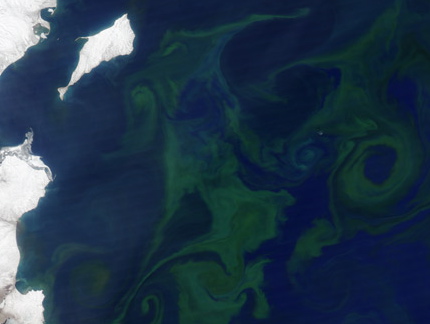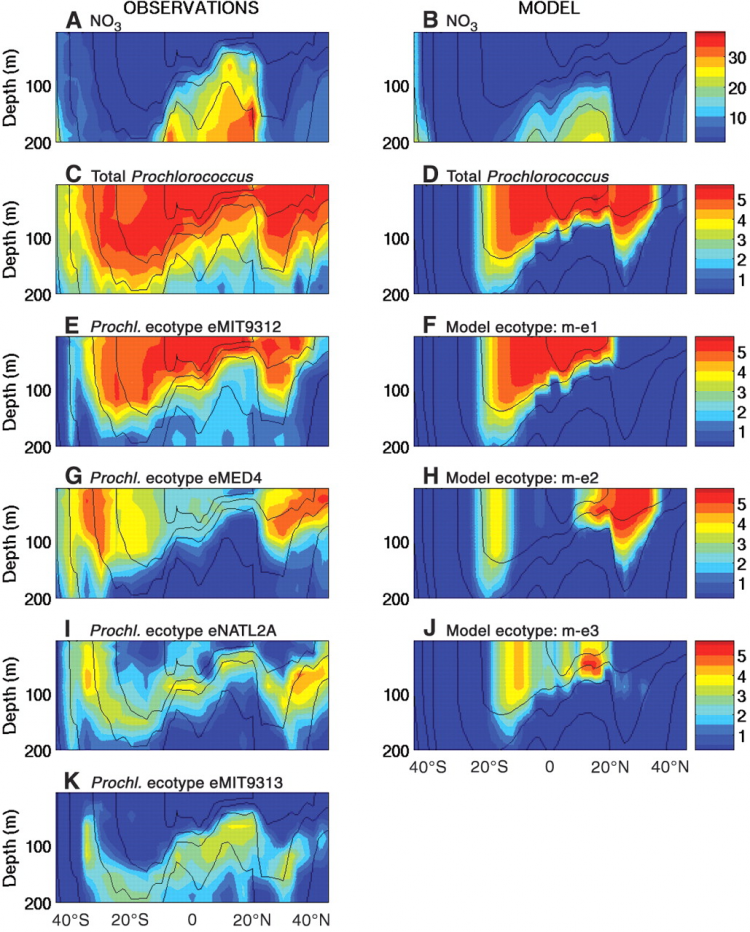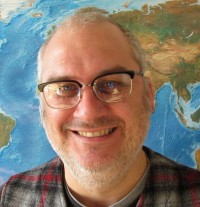Featured Stories, MIT - The Darwin Project, MIT EAPS | February 18, 2013
Mick Follows: Bringing Life to Computer Models of Marine Microbes
By Genevieve Wanucha
Today, biogeochemical modeler Michael (Mick) Follows rises to the top rung of the institution he’s called home for nearly 20 years. Follows came within inches of accepting a position elsewhere, but this formal promotion from Senior Research Scientist to Tenured Associate Professor means that he stays to contribute highly original thinking and enthusiasm to MIT’s ocean community.

As a member of the interdisciplinary Darwin Project in the MIT Earth Systems Initiative, Follows investigates the enormous role phytoplankton play in the ocean ecosystem. These tiny photosynthetic organisms float around by the billion in our global ocean, together providing half the world’s total oxygen and cycling carbon in our atmosphere and oceans. Follows doesn’t actually handle green slime; he tries to capture the “tangled wooly mess” of complex ecological relationships in numerical models, or computer-simulated oceans.
With his pierced ear and everyday outfit of jeans and a plaid flannel vest, it’s always easy to pick Follows out of a crowd. In the past, he’s been advised to blend in a little more, to look more like a professor. “But he never did change,” says John Marshall, an oceanographer at MIT who has known Follows for decades. “That’s what I like about him.” Members of his group, on the other hand, value Follows for his upbeat attitude and unending enthusiasm for research. “He’s full of ideas and new ways of doing things,” says Stephanie Dutkiewicz, Principal Research Scientist in the Darwin Project. “Sometimes too many ideas to handle.”
Marine microbes are unarguably a key piece in the puzzle of understanding how ocean ecology will change in a warming climate. For this reason, Follows often encounters the growing call in the microbiology community for a less crude incorporation of microbial processes into global ocean/climate models. “But that gets pretty hairy pretty quickly,” he says in an accent formed during a childhood in rural England. He means there’s a devil in the details.
The fact is, current models of plankton physiology are still based on the 1940s work of biological oceanographer pioneer Gordon Riley. “If Riley could look at global ocean models today, he wouldn’t find anything mysterious about the equations we use to describe plankton physiology,” says Follows, ever armed with historical context. Yet, 70 years of biological advances in genomics have yielded ways to map out the metabolic machinery of plankton cells in unprecedented detail. In short, the field needs a genius-level breakthrough in modeling if we are ever to incorporate the new data sets. “Maybe we need to ditch Riley at this point,” he admits.
Follows takes a pragmatic approach. “To me, its not clear how much of that detail matters for understanding what will happen to the carbon cycle over next 100 years,” he says. “I think there’s something in between where we can map out a broad-brush picture of what going on in the cell to give a more realistic, responsive physiology than we have now.”
Until about eight years ago, Follows hadn’t studied biology since high school. But that changed when his then graduate student, Fanny Monteiro (PhD ‘09), now at the University of Bristol, began to model nitrogen-fixing phytoplankton populations. She explored how this specific organism might coexist with the general population and adapt to changing conditions. Follows experienced what he calls a “brainwave.” He realized that the Darwinian principle of natural selection could transform modeling.

(Science, 315, 1843-1846, DOI: 10.1126/science.1138544.)
As any biologist knows, adaptive fitness shapes everything. The ability to adapt to certain conditions determines which phytoplankton physiologies survive or dominate. For example, large phytoplankton tend to have fast growth rates and a high demand for nutrients, whereas smaller phytoplankton grow more slowly but can survive in lower nutrient levels. This life process varies across space, time, and temperatures. And modeling it takes tremendous computing power.
In an unusual break from physical oceanography, Follows made his foray into biology by building a novel kind of model. Whereas previous models predetermined where certain phytoplankton populations should live in the ocean, Follows’ model uses only several hardwired rules (e.g. size, growth rate, nutrient needs), and then explicitly allows a diverse phytoplankton population to compete and self-organize according to temperature in the virtual environment. The model’s outputs reveal which physiological traits allowed some organisms to dominate an ocean region and which prevented survival in another.
The project won funding from the Moore Foundation in 2007, after the model’s outputs of phytoplankton distributions and traits matched up well with real-world observations. The group grew with new members from PAOC and the Department of Civil Engineering at MIT, becoming known as ‘the Darwin Project.’ Since then, the model has achieved similar successes, including the replication of observed phytoplankton diversity.
Some feel that Follows’ work has already triggered the sorely needed paradigm shift in biogeochemical modeling. “He is the first to couple Darwinian descriptions of microbiological processes with numerical models of the global ocean,” says Sallie (Penny) Chisholm, Professor of Environmental Studies in MIT’s Department of Civil and Environmental Engineering, who helped discover Prochlorococcus, the most abundant photosynthetic organism in 1988. “It is now possible to model co-evolution of these phenomena, revealing underlying drivers for emergent patterns of microbial diversity in the sea. This project has taken enormous intellectual courage.”
Follows is happy to remain at MIT to get closer and closer to understanding how diverse microbes impact the ocean’s carbon cycle. “I’m excited that you can follow your nose here,” he says. “This research environment is so rich in opportunities to collaborate with experts that you can let the science questions pull you in directions in you never thought you would go.” This announcement, made on Friday at State of EAPS 2013, means more than a promotion; Follows’ work could continue anywhere, but there’s only one place it could have begun.






